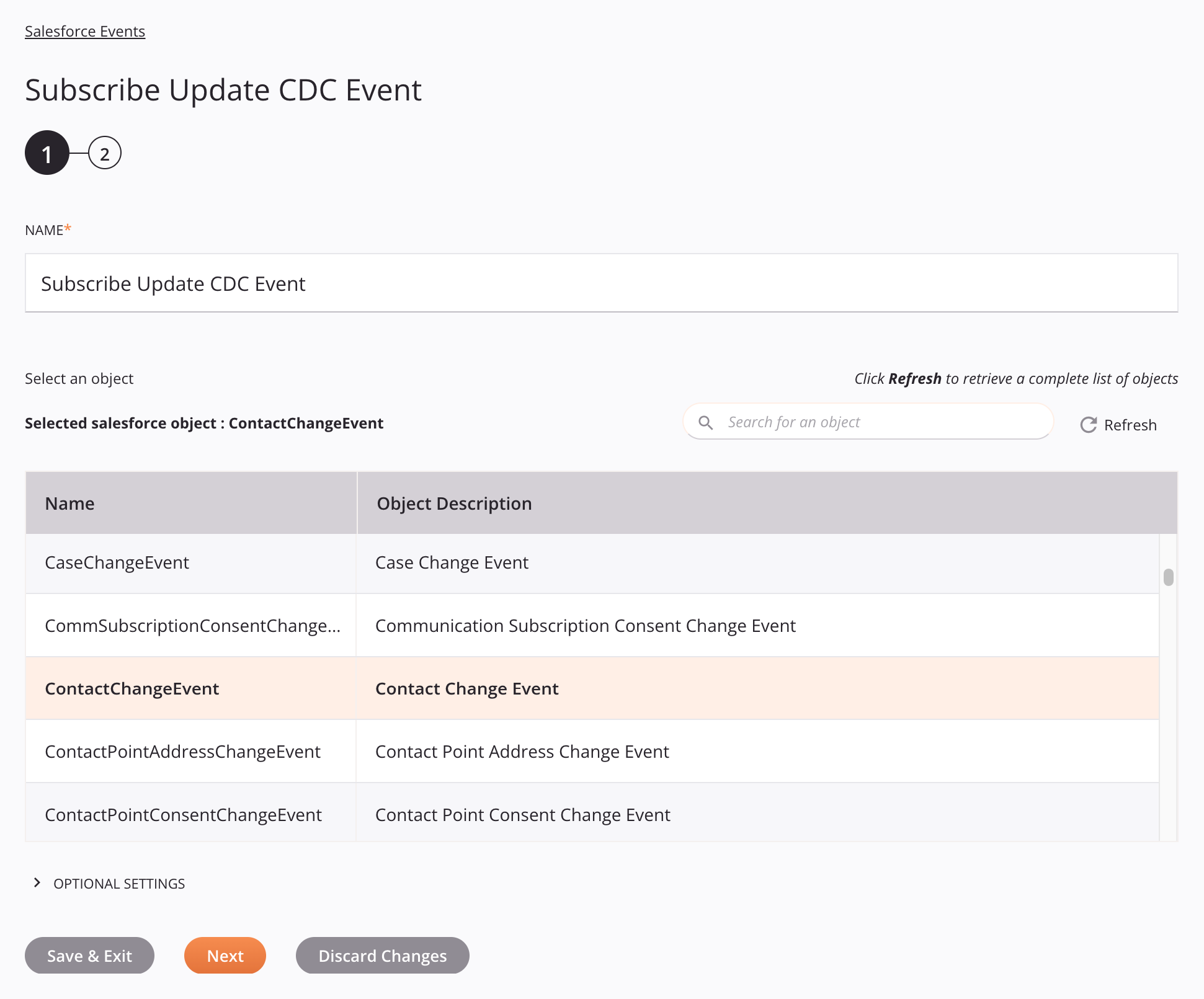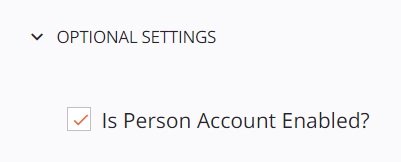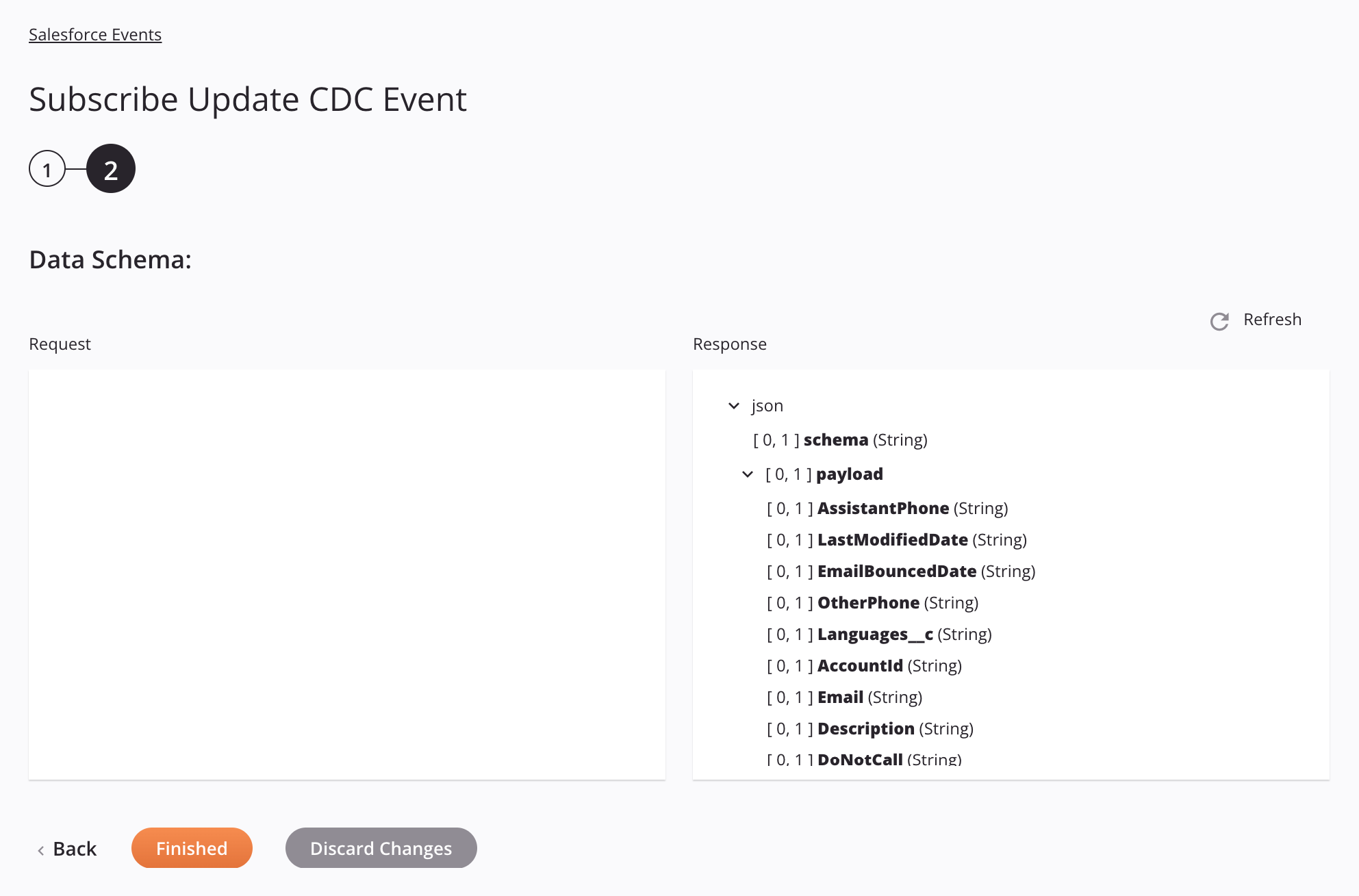Salesforce Events Subscribe Update Cdc Event activity¶
Introduction¶
A Salesforce Events Subscribe Update CDC Event activity, using its Salesforce Events connection, receives an update Change Data Capture (CDC) event from Salesforce and is intended to be used as a source to provide data in an operation.
Prerequisites¶
To use the Listen Message (Beta) activity, these prerequisites must be met:
-
Private agent version 10.68 / 11.6 or later is required if the group contains a single agent only. Private agent version 10.78 / 11.8 or later is required if the group contains multiple agents. To fully benefit from the listening service's load-balancing and fault-tolerance features, it is recommended to have a minimum of two agents in the agent group.
-
Each private agent must have the listening service enabled as described in Enable the listening service on the agent. This is a manual step in configuration and is not enabled by default.
-
Once an operation is deployed, the Cloud Studio project must have the listening service enabled at both the operation level and the activity level as described in Enable the listening service on the operation and activity. This is manual step performed at the time of project design or project management.
Create a Salesforce Events Subscribe Update Cdc Event activity¶
An instance of a Salesforce Events Subscribe Update CDC Event activity is created from a Salesforce Events connection using its Subscribe Update CDC Event activity type.
To create an instance of an activity, drag the activity type to the design canvas or copy the activity type and paste it on the design canvas. For details, see Creating an activity instance in Component reuse.
An existing Salesforce Events Subscribe Update CDC Event activity can be edited from these locations:
- The design canvas (see Component actions menu in Design canvas).
- The project pane's Components tab (see Component actions menu in Project pane Components tab).
Configure a Salesforce Events Subscribe Update Cdc Event activity¶
Follow these steps to configure a Salesforce Events Subscribe Update CDC Event activity:
-
Step 1: Enter a name and select an object
Provide a name for the activity and select an object. -
Step 2: Review the data schemas
Any request or response schemas generated from the endpoint are displayed.
Step 1: Enter a name and select an object¶
In this step, provide a name for the activity and select an object. Each user interface element of this step is described below.

-
Name: Enter a name to identify the activity. The name must be unique for each Salesforce Events Subscribe Update CDC Event activity and must not contain forward slashes
/or colons:. -
Select an Object: This section displays objects available in the Salesforce Events endpoint.
-
Selected Salesforce Object: After an object is selected, it is listed here.
-
Search: Enter any column's value into the search box to filter the list of objects. The search is not case-sensitive. If objects are already displayed within the table, the table results are filtered in real time with each keystroke. To reload objects from the endpoint when searching, enter search criteria and then refresh, as described below.
-
Refresh: Click the refresh icon
 or the word Refresh to reload objects from the Salesforce Events endpoint. This may be useful if objects have been added to Salesforce Events. This action refreshes all metadata used to build the table of objects displayed in the configuration.
or the word Refresh to reload objects from the Salesforce Events endpoint. This may be useful if objects have been added to Salesforce Events. This action refreshes all metadata used to build the table of objects displayed in the configuration. -
Selecting an Object: Within the table, click anywhere on a row to select an object. Only one object can be selected. The information available for each object is fetched from the Salesforce Events endpoint:
-
Name: The name of the object.
-
Object Description: The description of the object.
Tip
If the table does not populate with available objects, the Salesforce Events connection may not be successful. Ensure you are connected by reopening the connection and retesting the credentials.
-
-
Optional Settings: Click to expand additional optional settings:

- Is Person Account Enabled?: Select if the Salesforce instance has person accounts enabled. This controls whether
Namein the response schema is a node with multiple fields (when selected) or a single string field (when not selected).
- Is Person Account Enabled?: Select if the Salesforce instance has person accounts enabled. This controls whether
-
Save & Exit: If enabled, click to save the configuration for this step and close the activity configuration.
-
Next: Click to temporarily store the configuration for this step and continue to the next step. The configuration will not be saved until you click the Finished button on the last step.
-
Discard Changes: After making changes, click to close the configuration without saving changes made to any step. A message asks you to confirm that you want to discard changes.
Step 2: Review the data schemas¶
Any request or response schemas generated from the endpoint are displayed. Each user interface element of this step is described below.

-
Data Schemas: These data schemas are inherited by adjacent transformations and are displayed again during transformation mapping.
The Salesforce Events connector uses the Salesforce REST API version specified in the Salesforce Events connection. Refer to the API documentation for information on the schema nodes and fields.
Note
When the optional setting Is Person Account Enabled? is selected in step 1,
Namein the response schema is a node containing fields such asSuffix,FirstName,InformalName,LastName,MiddleName, andSalutation. When unselected,Nameis a single string field. -
Refresh: Click the refresh icon
 or the word Refresh to regenerate schemas from the Salesforce Events endpoint. This action also regenerates a schema in other locations throughout the project where the same schema is referenced, such as in an adjacent transformation.
or the word Refresh to regenerate schemas from the Salesforce Events endpoint. This action also regenerates a schema in other locations throughout the project where the same schema is referenced, such as in an adjacent transformation. -
Back: Click to temporarily store the configuration for this step and return to the previous step.
-
Finished: Click to save the configuration for all steps and close the activity configuration.
-
Discard Changes: After making changes, click to close the configuration without saving changes made to any step. A message asks you to confirm that you want to discard changes.
Next steps¶
After configuring a Salesforce Events Subscribe Update CDC Event activity, you first configure an operation, and then deploy the operation and enable events.
Configure an operation¶
Complete the configuration of the operation by adding and configuring other activities, transformations, or scripts as operation steps. You can also configure the operation settings, which include the ability to chain operations together that are in the same or different workflows.
Menu actions for an activity are accessible from the project pane and the design canvas. For details, see Activity actions menu in Connector basics.
Salesforce Events Subscribe Update CDC Event activities can be used as a source with these operation patterns:
- Transformation pattern
- Two-target archive pattern (as the first source only)
- Two-target HTTP archive pattern (as the first source only)
- Two-transformation pattern (as the first source only)
To use the activity with scripting functions, write the data to a temporary location and then use that temporary location in the scripting function.
Deploy the operation and enable events¶
Once the operation is configured, deploy it. Deploying the operation activates a toggle that is present at the bottom of the operation on the design canvas. By default, event listening is disabled.
To enable event listening for the operation, click the toggle:

When event listening is enabled, the operation will run when it is triggered by the configured event.
Note
Activities that listen to the same event in multiple operations or multiple projects will track those events separately and consume a message in each configured activity. That is, each operation configured with an enabled event will run when the event occurs.
After the operation triggers, you can validate behavior by checking the operation logs. A log entry is made for every message processed by the listening operation.
Administrators can also enable or disable event listening from the Management Console Projects page.
If you experience issues with the Salesforce Events connector, see the troubleshooting information.